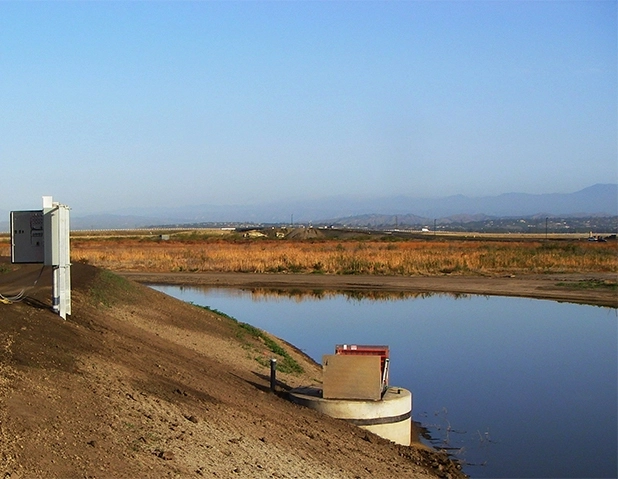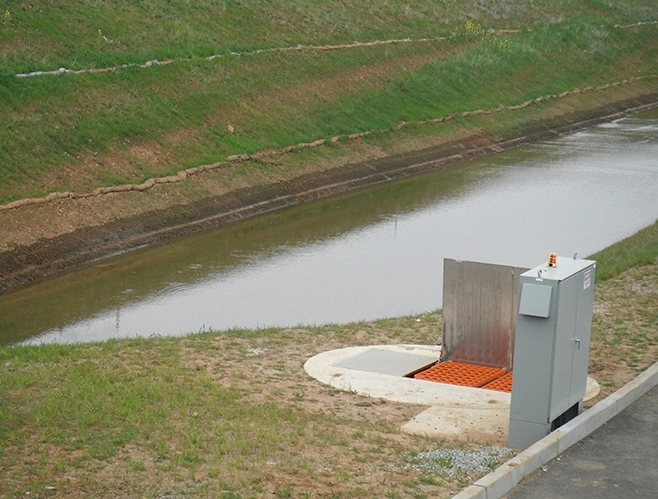
Romtec Utilities designs all types of stormwater pump stations, and a frequent scenario is pumping to or from a stormwater detention pond. Typically, a pump station that is pumping to or from a pond can be located in two economical places. The first place is locating the pump station adjacent to the pond in the berm (or essentially the bank of the pond). The second option is to locate the pump station in the pond itself. Romtec Utilities has used both approaches in designing, manufacturing, and supplying complete stormwater pump stations. Installing a pump station in the berm is almost always the best solution because it involves simple designs, common components, and easier long-term maintenance.
Installing the pump station in the berm of the pond is sometimes avoided because of the need for additional underground construction or intake structures. Although this is true, construction in the berm avoids many extraneous design scenarios. These scenarios include access to the station, system maintenance, and the structural nature of the wet well. Installing a pump station in the berm avoids these challenging scenarios.
The first scenario is access. When the pump station is installed in the berm, conduit, piping, and maintenance personnel all have access to the complete pump station. Placing the pump station in the berm also allows for vehicle access in most cases to provide winches, booms, or even just a toolbox. When the pump station is in the pond, access advantages become more difficult or even impossible to provide.

The second scenario is maintenance. Lift stations in the berm can be easily maintained because all of the components are accessible and engineered in a typical configuration. This means components like cable trays, disconnect stands, and valve vaults can all be utilized to make maintenance simple. A pump station in the pond requires suspended or buried conduit and piping (with all associated valves), as well as excessive cable lengths to a junction box or to the control panel. Extending the pump station connections into the pond has a cost associated with the extra length requirements but especially with maintenance requirements should a component fail.
The third scenario is the structural nature of the wet well. The typical precast concrete used by Romtec Utilities is designed to be installed in the ground. In this application, it is generally the most affordable structural solution. In the pond, the wet well can be a free-standing unit or submerged. Precast concrete is not designed to free stand, requiring higher-cost cast-in-place concrete, fiberglass, or steel wells instead. Submerged precast concrete -that is constructed flush with the bottom grade of the pond- does not have a structural drawback, but it certainly is the worst scenario for access and maintenance.
Aside from avoiding these problematic design scenarios, another benefit of installing a pump station in the berm is the ability to utilize a “flooded inlet line” with an inlet structure. A flooded inlet line allows the pump station to be installed at a shallow depth, marginalizing the construction costs associated with digging a hole in the berm. An inlet structure allows for screening of the pond water to ensure only water and small solids make it to the pump station. This reduces the construction costs for the pump station, creates a more simple design, and increases the functionality of the pump stations.

Installing the pump station in the detention pond is an approach that many engineers favor because it avoids additional underground construction or inlet structures. Typically, engineers envision a well that the water is able to simply flow into and get pumped. It sounds very simple. In order to make this approach work as a long-term solution, the major issue is addressing the access and maintenance concerns discussed above.
When the pump station is installed in the pond, conduit, piping, and human access all have to extend to the pump station. These necessities all add to the cost of the system and pose an access problem not faced by a pump station in the berm. For example, if a pump fails in the pond a method for pulling the pump needs to be devised. The best case scenario is a pump that is light enough to be pulled up by manpower and an OSHA approved walkway from the pump station to the bank of the pond. Otherwise, you must own or rent a crane to pull the pumps.
When considering the totality of pump station ownership, a stormwater pump station installed in the berm provides the best option for most applications. Romtec Utilities always utilizes the best approach for each project, and often times, this type of design is the simplest and most reliable for pumping stormwater out of a detention pond. Contact Romtec Utilities today to learn more about reliable pump station design solutions for stormwater pumping and any other pumping application.
